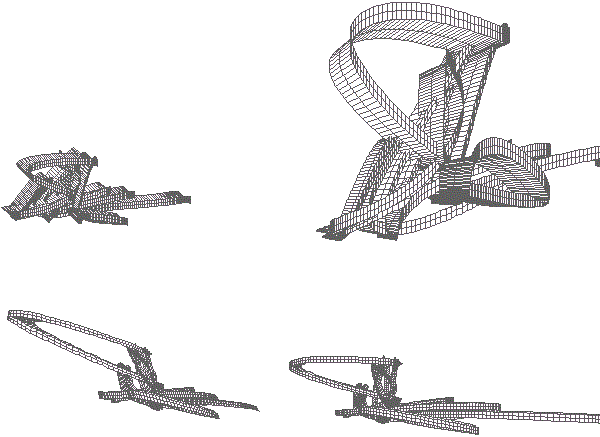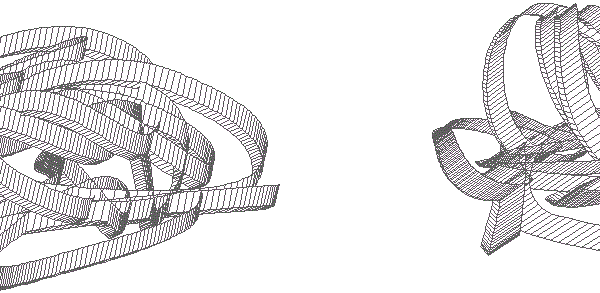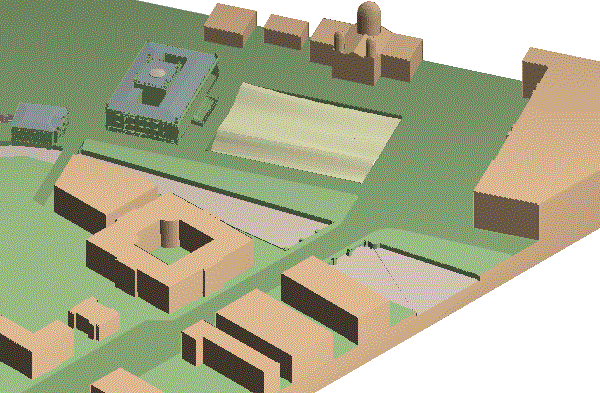2001.01.03
in "Beyond Style"
I spent a good bit of last weekend reading throughout Precis: Beyond Style (1985), and, as luck would have it, the articles by authors other than Stern and Libeskind were the most interesting and worthwhile.
"Building Metaphors" by Arthur C. Danto contained at least this one sentence which I had to repeat: "It is rather an architectural reenactment of a Renaissance reenactment of a dreamt classical city believed to be real, and because it is a city in connotation it can and does emblemize the city it is part of." Danto is referring to McKim, Mead and White's campus of Columbia University. Of course, I do not know the whole of architectural literature, but this quotation is the earliest direct connection between architecture (design) and reenactment that I come across thus far.
"On Style as Personal Expression" by Carlos Gomez de Llarena begins with: "Style, specifically the question of personal style, is hardly discussed today in architectural criticism and even less evident in teachings about architecture." Although I can't be at all certain, I imagine that the case of "personal style" is still the same today (ie, fifteen years since de Llarena's article.) I remember a woman, a fellow classmate in my first year design studio, who had an affinity for Art Nouveau, and she actually was able to apply an 'art nouveau' sensitivity to contemporary design projects. Of course, the woman was not exhibiting a solely personal style, rather I saw her as having found an affinity with the (established) style, and thus rendered application to her own designs. Further, of course, this woman's designs were consistantly chastised by the design critics. I hence always thought there might just be something terribly wrong about nipping creativity in the bud just because of "stylistic" differences. Anyway, de Llarena's article is a thorough analysis of (architectural) personal style and its more or less self-evident yet often denied implications.
"The Rise and Transformation of Modern Style: A Polemical History" by Edward Mendelson is a study of "High Modernism" versus "Low Modernism", and, although a little dated, nonetheless offers a neat way to dissect modernism. I now wonder if the term "Hyper Modernism" has yet been coined, that is, "beyond modern" as opposed to "post/after modern". I think a case can already be made for the classification of a Hyper Baroque, which is the European style corresponding to the century between roughly 1650 and 1750, and Hyper Size is perhaps the best description of what comes after S,M,L,XL.
Interestingly, in "Madness and the Combinative" Bernard Tschumi uses the word "hypertext" (which I'm guessing may have first been used within Tschumi's The Manhatten Transcripts, which I have not read). It was actually strange for me to see 'hypertext' associated with architecture fifteen years ago. It reminded me of the days (also fifteen years ago) when I used to regularly read The Face (a UK 'popular style' magazine). There were always lots of ads for new music CDs, mostly from groups or bands I never heard of. It never failed that when I looked through an issue of The Face that was a year old, I then recognized all the bands and music being advertised. The points being, introductions virtually always have a strong tint of foreign-ness, and it takes time for information to be assimilated. One of the reasons I like history is because you can often actually find those times when "traditions" first were foreign.

010106b
| |

010106d
2001.01.15
Quondam as hypermuseum
01. continuation of "Lauf Haus der Kunst".
02. lots of new museum (model and plan) play.
03. museum annex development.
04. the working title museum.
05. something to do with the Ryerss Museum.
06. the local acropolis.
08. a solarized "photography" exhibit.
10. IQ as the plan of a hypermuseum(?).
...Quondam as hypermuseum to be the manifestation of designing and practicing (architecture) in cyberspace ideas... Quondam to display an exploitation of data in the digital realm to create entities that (can) only exist in the digital realm.

010119b Lustgarten
| |
2001.01.27 11:07
(a poem) today
It is very
clear that the reality of architecture
today is that architecture
today is very diverse,
even hyper-diverse. There are
as many styles of
architecture today
as there are styles of
music today
as there are styles of
art today
as there are styles of
writing today.
The
design choices available
to an
architect, musician, artist and writer are virtually infinite
today. This hyper-abundance
of
choice substantiates the reality
of
relativity today.
The hyper-diversity of relative reality is architecture today.
2001.01.28
"Style" Redux
Tad said Paul said:
Being different is not the purpose of 'good architecture' nor a measure of 'good architects.
Steve wonders:
Does this mean that being the same is the purpose of 'good architecture' and the measure of 'good architects'? Or that being different is the purpose of 'bad architecture' and the measure of 'bad architects'?
I take the notion of 'being different' as antithetical to 'good architecture' as likewise being considered a sign that diversity in architecture is also antithetical to 'good architecture'? This make me ask then what and where is the coherence that constitutes 'good architecture' as it is executed on this planet today? To be specific, I am asking for 'concrete' examples that beyond any doubt clearly manifest the coherence of today's 'good architecture'. Actually, I'd rather address all of today's architecture, but I'm limiting my question to 'good architecture' to remain coherent with those that name coherence as 'good architecture'. Again, I'm looking for 'tangible' example of coherence, and will not accept answers that speak of a seeking of coherence because all that will tell me is that coherence is actually 'not there'.
I can point to one very good example of coherence in today's architecture, and, somewhat ironically, it is a coherence that began as a theory rejected by architectural education. I am speaking of BC's Architecture of Electricity thesis where electricity and electromagnetism are recognized as a manifestly pervasive architecture literally networked through all of today's architecture be it either 'good' or 'bad'. What I find fascinating about the architecture of electricity is that in so many infinite ways it is precisely electricity that engenders so much artistic diversity, especially today. And anyone who thinks the architecture of electricity is a subculture is making a mistake because thinking of the architecture of electricity as a hyper (ie, beyond) culture is already of a more correct understanding (but not necessarily of the best or conclusive understanding). Moreover, for those that might think the architecture of electricity does not constitute an architecture, let me remind you that if you are reading this on your computer screen right now, you are indeed experiencing one of the many diverse aspects of the architecture of electricity.
|